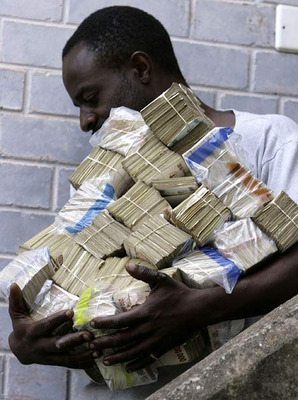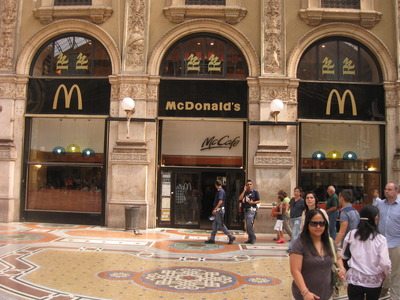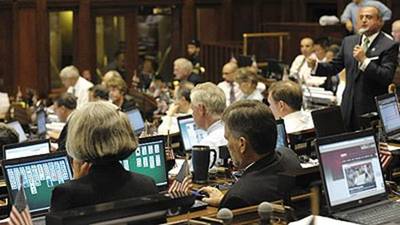
When the Dow crashed 514 points on August 8, 2010, the market lost a staggering $850 billion in market capitalization. High frequency traders were possibly responsible for half of this move, but generated a mere $65 million in profits, some 7/1,000?s of a percent of the total loss. Are market authorities and regulators being penny wise, but pound foolish?
The carnage the HF traders are causing is triggering a rising cry from market participants to ban the despised strategy. Many are calling for the return of the ?short sale test tick rule?, or SEC Rule 17 CFR 240.10a-1, otherwise known as the ?uptick rule?, which permits traders to execute short sales only if the previous trade caused an uptick in prices. The rule was created eons ago to prevent the sort of cascading, snowballing selling that we are seeing today. It was repealed on July 6, 2007. Check out a chart of the volatility that ensued and it will make your hair raise on the back of your neck.
Those unfamiliar with how algorithmic trading works see it as something akin to illegal front running. ?Co-location? of mainframes with exchange computers, or having them in adjacent rooms, gives them another head start over the rest of us. Much of the trading sees HF traders battling each other, and involves what used to be called ?spoofing?, the placing of large, out of the market orders with no intention of execution. Needless to say, if you or I tried any of these shenanigans, the SEC would lock us up in the can so fast it would make your head spin.
Many accuse exchange authorities of a conflict of interest, allowing members to reap sizeable custody fees from HF traders, while the rest of us get taken to the cleaners. Co-location fees run in the hundreds of thousands of dollars per customer. This is happening while traditional revenue sources, like proprietary trading, are disappearing, thanks to Dodd-Frank. There is no doubt that the volatility is driving the retail investor from the market. August has seen the highest equity mutual fund redemptions in history.
In fact, HF trading has been around since the late nineties, back when the uptick rule was still in place and colocation was a term out of Star Trek. But it was small potatoes then, confined to a few niche players like Renaissance, and certainly lacked the firepower to engineer 500 point market swings.
The big problem with this solution is that HF trading now account for up to 70% of the daily trading volume. Ban them, and the market volatility will shrink back to double digit trading ranges that will put us all asleep. The diminished liquidity might make it difficult for the 800 pound gorillas of the market, like Fidelity and Caplers, to execute trades, further frightening end investors from equities. It is possible that we have become so addicted to the crack cocaine that HF traders provide us that we can?t live without it?
?My feeling is that the bond market is grossly overvalued. We?re going to have 2%, 3%, 4% inflation. That?s what Bernanke is really saying. If we are going to have interest rates at zero for two years, that is actually going to push inflation up higher,? said professor Jeremy Siegel of the Wharton School of Business.
Europe has a big problem. No, it is not the continuing sovereign debt crisis, the lack of leadership, or the possible departure of up to a quarter of its membership, although these are all major worries.? Nor is it the Euro, the currency that everyone loves that has been declining for the last two years. No, the problem I am talking about is much worse than that. It is in fact so extreme that the union may not survive unless it is dealt with soon.
A Big Mac hamburger in Milan, Italy?s downtown Galleria cost me $7.50 on Monday. No, that is not for the entire meal, which includes the supersized Coke and French fries. That is just for the burger alone. This compares to $3.50 back home in the USA and only $3.00 in China.
And I can tell you that there is absolutely no difference between these three heart attacks on a plate, because I have eaten all three of them over the past year. The only real benefit of buying the Italian version is that they also had this cool espresso machine so you could wash down your lunch with a cappuccino or caf? latte.
I have written many times in the past about the Big Mac?s usefulness in measuring the relative value of foreign currencies using the theory of purchasing power parity. It is, after all, one of the few products sold in almost every country in the world which is uniformly identical. Thank American management for that, along with the world?s largest food logistics operation.
I have followed this indicator in earnest since my old employer, The Economist magazine in London, wrote it up as an April 1 spoof during the 1970?s. To their shock, their own arguments carried some merit and achieved a life of their own.
Last week, The Economist updated their closely watched indicator. It showed that the Norwegian kroner is 60% overvalued, fueled by its huge oil exports. The Hong Kong dollar sits at the bottom with a 50% undervaluation, gaining an edge from the cheap cost of labor and a low tax regime.
In the good old days, Italy could simply devalue the lira to make its Big Macs, and everything else it produces, internationally competitive. But since 1999, it has been trapped inside the European Monetary System, making this kind of instant cost cutting impossible. As long as Italy is pricing its Big Macs in Euro?s, it might as well be pricing them in in the old Deutchemarks. The same is true for Spain, Portugal, Ireland, and Greece. This does not bode well for the future of Europe.
Of course, if the Euro continues to fall, Italy might get some respite. But even if the Euro plunges to its old all-time low of 88 cents, down 28% from here, it would still have one of the world?s most expensive hamburgers. Maybe it?s time for Italians to become vegetarians. Maybe that is what is knocking the stuffing out of McDonalds (MCD) shares today.
I often get accused by readers of being a dinosaur, of being insensitive to the feelings of others, and of living as a relic from a previous age. Well, you all may be right. So it is with some amusement I run a piece that I have lifted from my friend, Dennis Gartman?s, The Gartman Letter, on the difference between going to school in 1957 and 2010:
Scenario 1:
Jack goes quail hunting before school and then pulls
into the school parking lot with his shotgun in his
truck's gun rack.
1957 - Vice Principal comes over, looks at Jack's
shotgun, goes to his car and gets his shotgun to show
Jack.
2010 - School goes into lock down, FBI called, Jack
hauled off to jail and never sees his truck or gun again.
Counselors called in for traumatized students and
teachers.
Scenario 2:
Johnny and Mark get into a fist fight after school.
1957 - Crowd gathers. Mark wins. Johnny and Mark
shake hands and end up buddies.
2010 - Police called and SWAT team arrives -- they
arrest both Johnny and Mark. They are both charged with
assault and both expelled even though Johnny started it.
Scenario 3:
Jeffrey will not be still in class, he disrupts other
students.
1957 - Jeffrey sent to the Principal's office and given a
good paddling by the Principal. He then returns to class,
sits still and does not disrupt class again.
2010 - Jeffrey is given huge doses of Ritalin. He
becomes a zombie. He is then tested for ADD. The family
gets extra money (SSI) from the government because
Jeffrey has a disability.
Scenario 4:
Billy breaks a window in his neighbor's car and his
Dad gives him a whipping with his belt.
1957 - Billy is more careful next time, grows up normal,
goes to college and becomes a successful businessman.
2010 - Billy's dad is arrested for child abuse, Billy is
removed to foster care and joins a gang. The state
psychologist is told by Billy's sister that she remembers
being abused herself and their dad goes to prison. Billy's
mom has an affair with the psychologist.
Scenario 5:
Mark gets a headache and takes some aspirin to
school.
1957 - Mark shares his aspirin with the Principal out on
the smoking dock.
2010 - The police are called and Mark is expelled from
school for drug violations. His car is then searched for
drugs and weapons.
Scenario 6:
Johnny takes apart leftover firecrackers from the
Fourth of July, puts them in a model airplane paint
bottle and blows up a red ant bed.
1957 - Ants die.
2010 - ATF, Homeland Security and the FBI are all
called. Johnny is charged with domestic terrorism. The
FBI investigates his parents - and all siblings are
removed from their home and all computers are
confiscated. Johnny's dad is placed on a terror watch list
and is never allowed to fly again.
Scenario 7:
Johnny falls while running during recess and
scrapes his knee. He is found crying by his teacher,
Mary. Mary hugs him to comfort him.
1957 - In a short time, Johnny feels better and goes on
playing.
2010 - Mary is accused of being a sexual predator and
loses her job. She faces 3 years in State Prison. Johnny
undergoes 5 years of therapy.
So True!
Our Leaders Hard at Work Solving Nation?s Problems
After my weekly dump on residential real estate, I feel obliged to reveal one corner of this beleaguered market that might actually make sense.
By 2050 the population of California will soar from 37 million to 50 million, and that of the US from 300 million to 400 million, according to data released by the US Census Bureau and the CIA fact Book (check out the population pyramid below).
That means enormous demand for the low end of the housing market?apartments in multi-family dwellings. Many of our new citizens will be cash short immigrants. They will be joined by generational demand for limited rental housing by 65 million Gen Xer?s and 85 million Millennials enduring a lower standard of living than their parents and grandparents. These people aren?t going to be living in cardboard boxes under freeway overpasses.
The trend towards apartments also fits neatly with the downsizing needs of 80 million retiring Baby Boomers. As they age, boomers are moving from an average home size of 2,500 sq. ft. down to 1,000 sq ft condos and eventually 100 sq. ft. rooms in assisted living facilities. The cumulative shrinkage in demand for housing amounts to about 4 billion sq. ft. a year, the equivalent of a city the size of San Francisco.
Four years after our economic collapse, rents are one of the few areas in real estate that have been consistently rising in price. Fannie and Freddie financing is still abundantly available at the lowest interest rates on record. Institutions combing the landscape for low volatility cash flows and limited risk are starting to pour money in.
In Your Future?
Some 18 months ago, bank research analyst Meredith Whitney is predicted that the dire straits of state and local finances would trigger a collapse of the municipal bond market that would resemble the Sack of Rome. She believed that total defaults could hit 2,000 issues and reach $100 billion in value. Those sharp edged comments caused the main muni bond ETF (MUB) to plunge from $106 to $97.
So how did that forecast do? Since then, muni bonds have been one of the top performing asset classes in the financial market. (MUB) has soared from 92 to 113, a gain of 23%. As for the number of defaults? The amounted to a handful worth only a few million dollars. Try again Meredith!
I didn?t buy it for a second. States are looking at debt to GDP ratios of 4% compared to nearly 100% for the federal government, which still maintains its triple ?A? rating. They are miles away from the 130% of GDP that triggered defaults and emerging refinancing?s by Greece, Portugal, and Ireland.
The default risk of muni paper is vastly exaggerated. I have read the prospectii of several California issues and found them at the absolute top of the seniority scale in the state?s obligations. Teachers will starve, police and firemen will go on strike, and there will be rioting in the streets before a single interest payment is missed to bond holders.
How many municipal defaults have we actually seen in the last 20 years? The nearby City of Vallejo, where policemen earn $140,000 a year, is one of the worst run organizations on the planet. And Orange County got its knickers in a twist betting their entire treasury on a complex derivatives strategy that they clearly didn?t understand sold by, guess who, Goldman Sachs. They were recently joined by the city of Stockton, California. To find municipal defaults in any real numbers you have to go back 80 years to the Great Depression.
My guess is that we will see a rise in muni bond defaults. But it will be from two to only 20, not the hundreds that Whitney is forecasting. Let me preface my call here that I don?t know anything about the muni bond market. It has long been a boring, quiet backwater of the debt markets. At Morgan Stanley, this is where you sent the new recruit with the ?C? average from a second tier school who you had to hire because his dad was a major client. I have spent most of my life working with hedge funds, major offshore institutions, and foreign governments for whom the tax advantages of owning munis have no value.
However, I do know how to use a calculator. Top quality ?AAA? muni bonds now carry 3% yields. If you buy bonds from you local issuer, you can duck the city, state, and federal tax due on equivalent grade corporate paper. That gives you a pre tax yield as high as 6%, depending on where you live. While the market has gotten a little thin, prices from here are going to get huge support from these coupons.
Since the tax advantages of these arcane instruments are highly local, sometimes depending on what neighborhood you live in, I suggest talking to a financial adviser to obtain some tailor made recommendations. There is no trade for me here. I just get irritated when conflicted analysts give bad advice to my readers and laugh all the way to the bank. Thought you should know.
There is another factor that will support this market. When taxes go up, and they almost certainly will no matter who wins the presidential election, the tax free aspect of muni bonds also increases. That makes them a ?buy? in my book. But only a buy and hold. They way to play it safe here is to only invest in maturities that match your cash flow needs. They way you can ignore the market gyrations and hold everything to maturity. For most investors, that means limited maturities to 10 years or less.
This is Not the Muni Bond Market
Milan, Italy appears to be a city entirely populated by fashion models riding bicycles on the city?s frenetic streets. That is one?s first impression coming out of the monolithic Milano Centrale train station, built by Mussolini to reaffirm faith in his state. Despite years of allied bombing during WWII, the building is as imposing as the day it was built.
You Think It?s Easy Fitting into a Size 0?
I came to this medieval city to speak at another strategy luncheon, which was attended by readers from throughout Europe, from the surgeon hailing from Trondheim, Norway, to the Hungarian hedge fund manager. The Westin Hotel provided a spectacular lunch, as only the Italians can.
We discussed various breakup scenarios for the EC which come into vogue every time Greek debt gets downgraded, which is often. This is unlikely, given the modern European?s dislike for open conflict. Bring nationalism into the equation, and things could deteriorate quickly. Germany could bail, unwilling to refinance the debt of lazy, tax avoiding, garlic eaters. Southern Europe could do a disappearing act, unwilling to pay their debts to the sauerkraut eaters up North.
Yes, I Can Be Bribed
In either case, the European currency bloc shrinks, or disappears completely. It is just a matter of time before an opportunistic political party rides this fast track into power. The Germans will tell you from hard earned experience that this always ends badly.
I had exactly one free afternoon to spend in this amazing city. I visited Da Vinci's The Last Supper at Santa Maria della Grazie monastery, looking for evidence of the conspiracy theories long ascribed to this masterpiece. I did a quick run through the Galleria and stepped on the bull?s balls, conducting three clockwise rotations to bring good luck. Looking at my performance since then, it obviously worked. The impact of the fashion industry on Milan is enormous, with every conceivable brand imaginable on show.
I managed to duck into the main Brioni store just before closing. There, I watched two Russian Mafia types in their thirties buy a half dozen exquisitely tailored, 200 thread count suits each for $6,000 apiece. That?s $72,000 worth of clothes?. for guys!
Alas, they don?t carry an American size 48 long in stock, it would have to be a custom order, so I left with only a couple of Leonardo ties in hand. It turns out that Brioni doesn?t manufacture suits for big guys anymore. The company has downsized production to fit Chinese and Russian customers off the rack, where the big money is these days. In any case, I happen to know that I can get the identical suit at the Brioni shop Caesar?s Palace in Las Vegas for a third less, plus they likely have my size. And I will be there in two months for a strategy luncheon.
The next morning found me in a mad dash back to the train station, my taxi driver artfully weaving in and out of traffic, where I boarded a first class Eurostar train. The engine powered North towards the Italian Alps, passing through the Milan slums. Retracing the route seen in the classic Frank Sinatra war flick, Von Ryan?s Express.
After my entertaining repast with the head of our nation?s intelligence service, I had to ask myself this question.
During the sixties, new dwarf varieties, irrigation, fertilizer, and heavy duty pesticides tripled crop yields, unleashing a green revolution. But guess what? The world population has doubled from 3.5 to 7 billion since then, eating up surpluses, and is expected to rise to 9 billion by 2050.
Now we are running out of water in key areas like the American West and Northern India, droughts are hitting Australia, Africa, and China, soil is exhausted, and global warming is shriveling yields. Water supplies are so polluted with toxic pesticide residues that rural cancer rates are soaring.
Food reserves are now at 20 year lows. Rising emerging market standards of living are consuming more and better food, with Chinese pork demand rising 45% from 1993 to 2005. The problem is that meat is an incredibly inefficient calorie transmission mechanism, creating demand for five times more grain than just eating the grain alone.
To produce one pound of beef, you need 16 pounds of grain and over 2,000 gallons of water! I won?t even mention the strain the politically inspired ethanol and biofuel programs have placed on the food supply. Burning food so you can drive your GM Suburban to Wal-Mart on the weekends while millions are starving never made much sense to me.
It is possible that genetic engineering, sustainable farming, and smart irrigation could lead to a second green revolution, but the burden is on scientists to deliver.
The amount of arable land per person has fallen precipitously since 1960, from 1.1 acres to 0.6 acres, and that could halve again by 2050. Water is about to become even more scarce than land. Productivity gains from new seed types are hitting a wall.
China, especially, is in a pickle because it has 20% of the world?s population, but only 7% of the arable land. It has committed $5 billion to develop agricultural land in Africa. There are now thought to be over one million Chinese agricultural workers on the Dark Continent. Similarly, South Korea has leased half the arable land in Madagascar to insure their own food supplies.
An impending global famine has not escaped the notice of major hedge funds. George Soros has snatched up 650,000 acres of land in Argentina and Brazil on the cheap, an area half the size of Rhode Island, Others are getting into the game, quietly building portfolios of farms in the Midwest and the South.
This year promises to deliver one of the greatest US crop yields in history, brought on by the warmest winter in 100 years. The US Dept. of Agricultural January crop report then predicted huge surpluses, slamming prices once again, and delivering limit down moves in the futures markets. But the weather may not cooperate, as it did last year.
The net net of all of this is that food prices are going up, a lot. Use this year?s expected weakness in prices to build core long positions in corn, wheat, and soybeans, as well as in the second derivative plays like Potash (POT), Agrium (AGU) and Monsanto (MON). You might also look at the PowerShares Multi Sector Agricultural ETF (DBA) and the Market Vectors Agribusiness ETF (MOO).
A ?BUY? SIGNAL?
The original purpose of this letter was to build a database of ideas to draw on in the management of my hedge fund. When a certain trade comes into play, I merely type in the symbol, name, currency, or commodity into the search box, and the entire fundamental argument in favor of that position pops up. With a link chain to older stories.
You can do the same. Just type anything into the search box with the little magnifying glass in the upper right hand corner of my homepage and a cornucopia of data, charts, and opinion will appear. Even the price of camels in India (to find out why they?re going up, click here). As of today, the database goes back to February 2008, and comprises some 2 million words, or triple the length of Tolstoy?s epic novel, War and Peace.
Watching the traffic over time, I can tell you how the database is being used, and the implications are fascinating:
1) Small hedge funds want to see what the large hedge funds are doing.
2) Large hedge funds look to see what they have missed, which is usually nothing.
3) Midwestern advisors to find out what is happening in New York and Chicago.
4) American investors to find out if there are any opportunities overseas (there are lots).
5) Foreign investors wish to find out what the hell is happening in the US (about 1,000 inquiries a day come in through Google?s translation software in a multitude of languages).
6) Specialist traders in stocks, bonds, currencies, commodities, and precious metals are looking for cross market insights which will give them a trading advantage with their own book.
7) High net worth individuals managing their own portfolios so they don?t get screwed on management fees.
8) Low net worth individuals, students, and the military looking to expand their knowledge of financial markets (lots of free online time in the Navy).
9) People at the Treasury and the Fed trying to find out what the private sector is doing.
10) Staff at the SEC and the CFTC to see if there is anything new they should be regulating.
11) More staff at the Congress and the Senate looking for new hot button issue to distort and obfuscate.
12) Yet, even more staff in Obama?s office gauging his popularity and the reception of his policies.
13) As far as I know, no justices at the Supreme Court read my letter. They?re all closet indexers.
14) Potential investors/subscribers attempting to ascertain if I have the slightest idea of what I am talking about.
15) Me trying to remember trades which I recommended, but have forgotten.
16) Me looking for trades that worked so I can say ?I told you so.?
It?s there, it?s free, so please use it.
There is no end to which I am willing to go to understand the future direction of the world economy. So when I learned that the price of Brazilian bikini waxes was going through the roof, I had to sit up and take note. Last month, the price of the popular beauty treatment soared by 16.6% to 35 Reals, about $22.
This is no joke. The Brazilian government includes the removal of body hair in the most strategic of places in a basket of consumer services that it uses in calculating the country?s inflation rate, now estimated at 6.5%. An economist in Rio de Janeiro assured me that this has nothing to do with the opposite sex. It is one of the few measures they track which can?t be clouded through the surreptitious altering of its quantity or quality. You either get it, or you don?t.
The big picture here is that inflation is worsening, not only in Brazil, but other emerging markets, like China, India, and Vietnam. This is why the yields on one year Brazilian debt are at sky high double digits, a hedge fund favorite. It is also why the People?s Bank of China?s efforts to stanch inflation through higher interest rates and tightened bank reserve requirements are likely to get worse before are gets better.
What can I say? An economic indicator in the hand is worth two in the bush? And I won?t even get into the implications of ?Stealth? inflation.
































